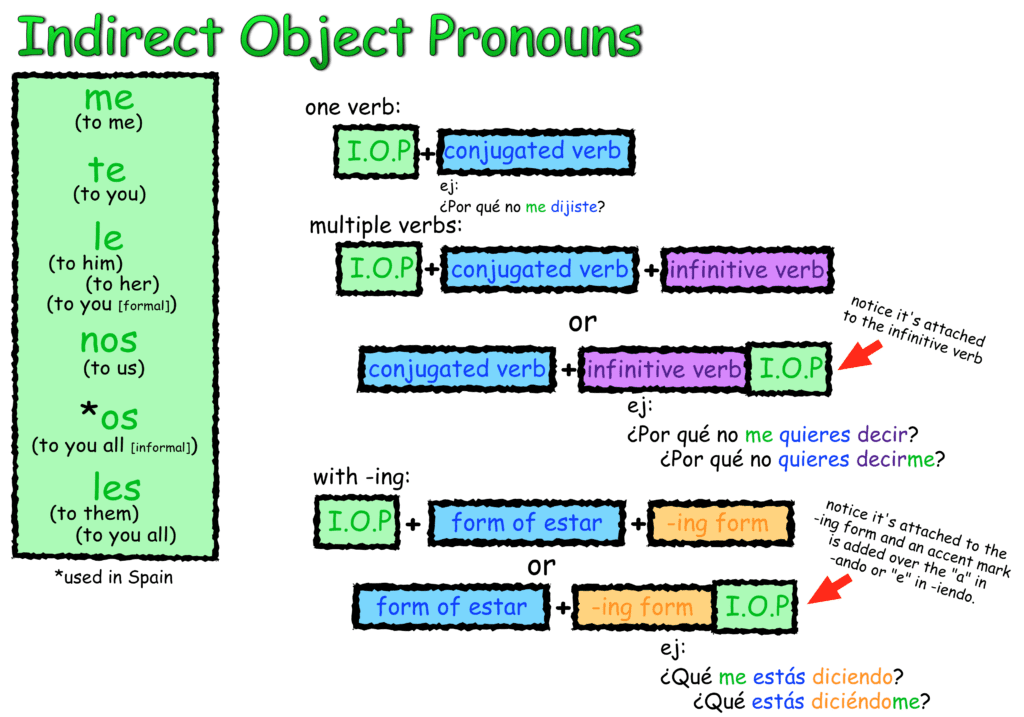The indirect object of a sentence is the recipient of the direct object. As we discussed in our previous lesson, the direct object is the thing being acted on by the verb. On the other hand, a great way to recognize the indirect object is to ask yourself to whom or for whom an action is being completed. In other words, the indirect object (IO) tells us who or what receives the direct object (DO).
Start your Spanish Classes Today!
Lets take a look at the examples below:
- She gives the cookies to her brother.
- DO=Cookies
- Where are the cookies going?
- To her brother
- IO=her brother
- She gives her brother the cookies.
- DO=Cookies
- Who are the cookies going to?
- To her brother
- IO=her brother
When an indirect object is present in a sentence, it is almost always accompanied by a direct object. It is important to keep in mind that the indirect object tells us where or to whom the direct object is going. Below you will notice how the following sentences just would not work without a DO:
She gives her brother…
She gives her brother… what? A present, a ball, a book etc.
Many times the direct is not stated but rather it is implied by the context of the sentence:
- My husband cooks for me every night.
- DO=dinner (understood)
- IO=me
- (My husband cooks dinner for me every night.)
In Spanish, when the indirect object is replaced by a pronoun, we use the following:
- me (me)
- te (you-familiar)
- le (him, her, you-formal)
- nos (us)
- les (them, you-all-formal)
In an affirmative sentence the indirect object pronoun is placed directly before the correct form of the conjugated verb:
| Spanish | English |
| Nacho me cocina la cena. | Nacho cooks me dinner. |
| Nacho te cocina la cena. | Nacho cooks you dinner. |
| Nacho le cocina la cena. | Nacho cooks him/her dinner. |
| Nacho nos cocina la cena. | Nacho cooks us dinner. |
| Nacho les cocina la cena. | Nacho cooks them dinner. |
Now, take a look at the previous examples again. Notice how the IO (indirect object) phrase is underlined with their English equivalent in parenthesis:
| Spanish | English |
| Nacho me cocina la cena.(cooks for me) | Nacho cooks me dinner. |
| Nacho te cocina la cena. (cooks for you) | Nacho cooks you dinner. |
| Nacho le cocina la cena. (cooks for him/her) | Nacho cooks him/her dinner. |
| Nacho nos cocina la cena. (cooks for us) | Nacho cooks us dinner. |
| Nacho les cocina la cena. (cooks for them) | Nacho cooks them dinner. |


Similarly to the direct object, the indirect object cannot be translated directly word-for-word:
- Nacho me cocina la cena.
- Nacho for me cooks dinner.
The key to learning the uses of the indirect object pronouns is similar for direct object pronouns. It is important to think in phrases rather than a word-for-word translation. The phrases contain a pronoun and a conjugated verb.
In the following examples, notice that the indirect object stays the same, but the subject (conjugated verb) changes:
| Spanish | English |
| Me cocinás | You cook for me |
| Me cocina | He/she cooks for me |
| Me cocinan | They cook for me |
The indirect object pronouns le and les can be particularly tricky sometimes because they are ambiguous since they can mean different things:
- le
- to/ for him
- to/ for her
- to/ for you (singular – formal)
- les
- to/ for them
- to/ for you (plural)
The following sentences, while grammatically correct, are ambiguous:
- Él le cocina la cena.
- He cooks him dinner.
- He cooks her dinner.
- He cooks you (singular – formal) dinner.
- Él les cocina la cena
- He cooks them dinner.
- He cooks you-all dinner.
Since it can be difficult to decipher what le and les are referring to without context, a prepositional phrase is often used for clarity.
- Él le cocina a Nacho la cena.
- Él le cocina a su hermana la cena.
- Ella le cocina a usted la cena.
- Él les cocina a sus padres la cena.
- Él les cocina a ustedes la cena.
Note: sometimes a prepositional phrase is used for the sole purpose of adding emphasis.
Here’s the takeaway on IO:
- The IO tells us to whom or where the DO is going.
- You almost always need a DO in a sentence that have an IO.
- On some occasions, the DO is not stated, but implied or understood from context.
- The IO pronouns are: me, te, le, nos, and les.
- The pronoun always comes before the conjugated verb.
- It is important to think in phrases and context rather than translating word for word.
- Le and les can be ambiguous.
- Prepositional phrases are often used to give context and add emphasis.
Check our Free Spanish Classes here or sign up for online Spanish classes




